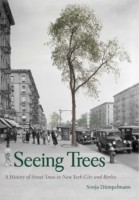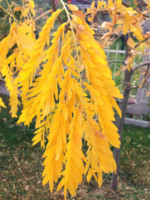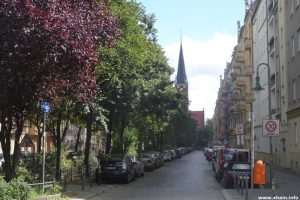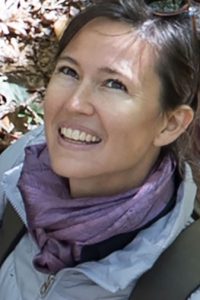AUTHOR INTERVIEW: SONJA DÜMPELMANN

Sonja Dümpelmann is a highly-accomplished scholar of Landscape Architecture on the faculty of the University of Pennsylvania’s Stuart Weitzman School of Design.
Her latest book — SEEING TREES, A History of Street Trees in New York City and Berlin — is full of fascinating information presented with an appealing flow.

And I am now pleased to be able to present my recent interview with Dr. Dümpelmann.
What three main things would you hope for a general reader to take away from their reading of SEEING TREES?
I hope this book offers readers new ways to, indeed, really “see” trees, and that is, to see trees in a new, multifaceted light; to see how political their planting and existence in urban areas is.
I also hope the book will contribute to an understanding of how fragile — and yet powerful –designed landscapes can be and how street trees can have an enormous positive impact on our lives. And third, I hope the book shows how important it is to care about, and to care for, the public urban realm, i.e. the urban space also occupied by street trees.
Please tell us about one of your favorite trees, or groupings of trees, in New York City.
Thinking back to my first visits in the city, the thornless honey locust trees in Paley Park and Greenacre Park were among the trees that made a big impression on me. I adore urban honey locust trees. They are so gentle and elegant; their feathered leaves, which turn beautifully yellow in the fall, provide a light, airy effect that contrasts with densely built-up Midtown. They look very “lively” to me. At the same time, they have a sculptural quality and often cast interesting, intricate shadows.

(Honey locust leaves in autumn. Photo credit here.)
And what are some of your favorite trees in Berlin?
Like NYC, Berlin has many streets which are lined with London plane trees. Kollwitzstraße in Prenzlauer Berg is lined with beautiful old specimens bowed towards the roadway, thereby creating a tunneled arbor. The way sunlight is filtered through these trees in the summer, casting shadows on the adjacent facades and the street, creates an atmosphere which I find soothing and relaxing. The trees slow down the pace of life. I have also always been fascinated by the mottled bark of London plane trees which peels off and is shed as they grow and trunks expand. All those tones of green, brown and yellow form individual patterns unique to each tree which I find very beautiful.

(London plane tree, leaves and bark. Photo credit here.)
Another space that would not be the same without trees, is Bänschstraße in Friedrichshain. It’s near where I live when I am in Berlin. Bänschstraße has a tree-lined median, a kind of linear park with a central walkway and benches, leading up to Samariterkirche (ed. — A church). Although there are other similar urban ensembles throughout the city, I still find it quite an extraordinary urban design and space. It opens up the urban fabric, slows down traffic, and turns this part of the city into a very livable environment.

(Berlin’s Bänschstraße is named for Willi Bänsch, a German who resisted the Nazis.)
You came to SEEING TREES with considerable existing knowledge of the topic(s). What in your research for the book most surprised you?
Every new book project is a journey with exciting findings and surprises for me and thus is a very enriching learning experience. These are some of the reasons why I enjoy researching and writing so much.
When you study cities from the point of view of their trees, you quickly realize how entangled the environmental, social and political worlds are.
And while this is something that to me as a landscape historian is, of course, quite obvious, I still found it exciting to see just how many ramifications there were. While the involvement of women in twentieth-century urban street tree planting initiatives, particularly in the US-American context, was perhaps not that surprising — given American women’s involvement in nineteenth-century village beautification and forest conservation efforts — the extent of their engagement was interesting for me to see.
And yet, the urban forestry profession continues to be quite male dominated, though this is slowly changing.
It was also very interesting to find how pervasive street tree planting as an act of empowerment has been in very different political and cultural contexts.
Among other things, I think this shows the power of trees: people have always gathered around trees and they still do, for diverse causes which do not always directly have to do with the tree, or the environment, for that matter.
Researching Berlin was an opportunity for me to learn more about East Germany and East Berlin. I grew up in West Germany during the Cold War without family ties to East Germany. It was fascinating to see how the Western Allies’ plans to fell street trees for fire wood during the Berlin Blockade incited one of the first ideological battles of the Cold War. Furthermore, it was interesting to see that many ideas about street tree planting and management were very advanced and progressive in East Germany. That caused surprise and envy in West German landscape and urban forestry circles, despite the fact that planting plans in East German cities could seldom be realized as planned, given the lack of adequate planting material. There were many other small stories that were surprising, unexpected findings, and in many cases, they were also horrifying and harrowing.
For example, the year after Germany had begun the Second World War with attacks on Poland, Berlin’s garden director Joseph Pertl had thousands of young trees transported to Berlin from a confiscated Polish tree nursery. These trees were supposed to ultimately line the east-west axis in Albert Speer’s megalomaniac design for Hitler’s “Germania.” While trains were deporting Jews to the concentration camps — often located in wooded areas “out of view” in Poland and elsewhere — trains were transporting confiscated trees in the opposite direction where they were to be planted on a planned showcase street to celebrate the Nazis and their capital.
Another story is that only a few weeks before Germany’s capitulation and the Battle of Berlin, the city’s district departments of gardens were asked to report on the potential yield of mountain ash berries from street trees. This futile undertaking revealed how street trees had become enlisted in Nazi biopolitics: mountain ash berries have a very high concentration of vitamin C and ascorbic acid, and with the advancement of the Allied Forces on German territory it had become clear that Berlin itself would need to provide the resources for its citizens’ survival.
Do you recall how urban trees enhanced the time you spent at the University of the Arts, Berlin?
One of the things I will always remember from that time is the rather ephemeral effect of Berlin’s trees on fine autumn days when the air was already cold. On occasion, a heavy mist would slowly dissolve to let the sun come through and turn linden and maple leaves into a golden glow. You could smell the dampness of fallen leaves. I can get nostalgic about the walks I sometimes took on autumn and winter weekends along the tree-lined Spree River in Charlottenburg and Moabit to Konditorei Buchwald (Buchwald is German for “beech woods”.) True to its name, the bakery, founded in 1852, is known for its Baumkuchen (“tree cake”), one of my favorite cakes!

(The Konditorei Buchwald in Berlin)
Out of curiosity, how did you first become interested in the history of landscape architecture?
I became interested in landscape history when studying landscape architecture at university. The landscape history professor tragically died during my first semester and was not replaced until after I had finished my studies years later.
I attended lectures in architectural history, but it bothered me that I did not know anything about the history of landscape design. How could I develop visions and design for the future if I did not know about the past?
My solution was to write a master’s thesis which dealt with the history of landscape. I wrote it on the development of the first public urban parks in northern Italy in the nineteenth century. I went on to write a PhD dissertation on one of the first professional female landscape architects in Italy and landscape design during Italian fascism.
*****
Sonja Dümpelmann’s book SEEING TREES is here on Amazon and here on Barnes & Noble.
Her University of Pennsylvania faculty page is here.

